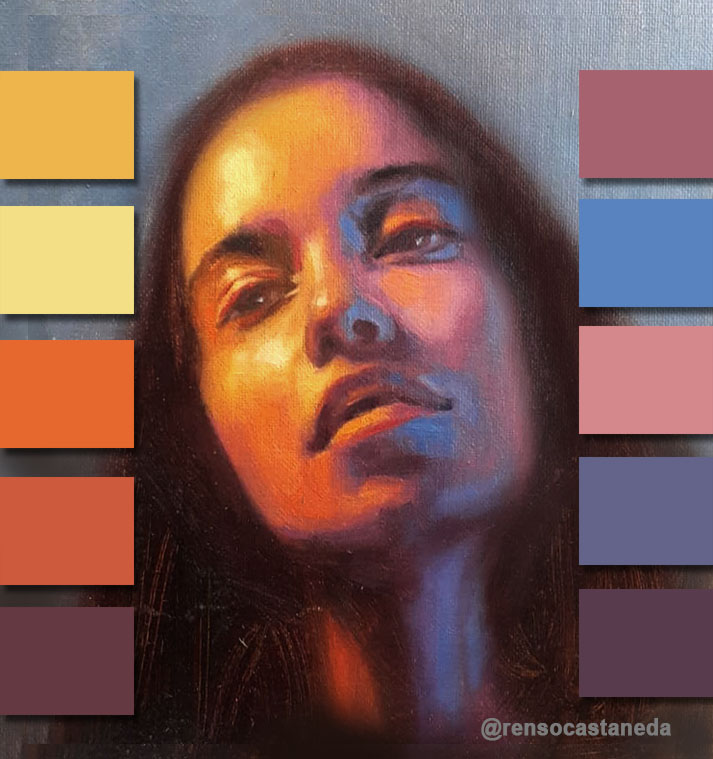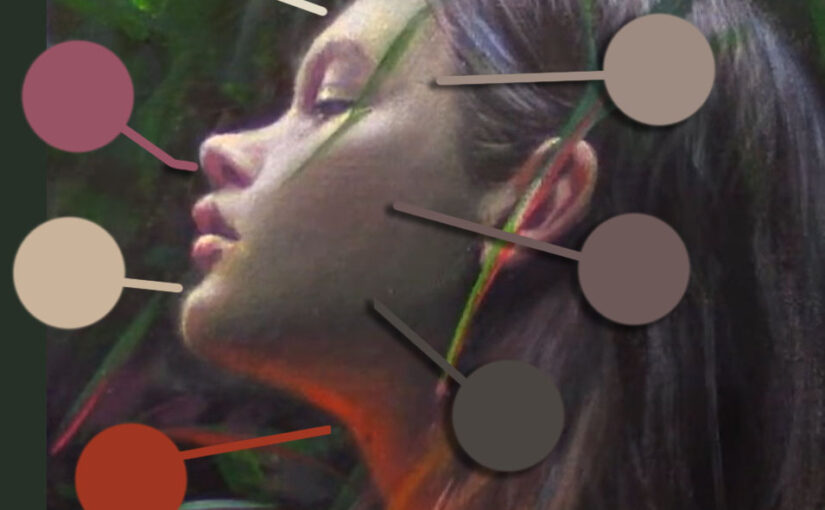Think back to a day at the beach—just before sunset. The sun’s golden light spreads across the sky, bathing everything in yellows and oranges. Meanwhile, the sand, once warm and golden at noon, now takes on a violet or purple hue as shadows grow.
Just writing about this scene brings back memories for me. It’s a perfect example of color temperature—the relationship between warm and cool colors that we see around us every day. Sometimes the contrast is subtle, other times it’s strong, but it’s always present. As artists, our job is to capture this balance on canvas.

Understanding Color Temperature
In color theory, there is a fundamental principle:
➡ If the light is warm, the shadows must be cool.
➡ If the light is cool, the shadows must be warm.
This contrast in temperature is essential to creating a sense of volume, form, and realism in paintings. If we ignore this rule, our artwork will feel flat or unnatural—even if viewers can’t pinpoint why.
It’s easy to get lost in the flow of painting and forget about theory, but color temperature should always be in the back of your mind—like a soft whisper guiding your brush.
What Are Warm and Cool Colors?
The easiest way to understand color temperature is to think about real-world temperature associations:
Warm and cool colors are categories of colors based on their visual temperature associations. They influence mood, perception, and design aesthetics.
Warm Colors
- Examples: Reds, oranges, yellows, and some browns.
- Associations: Fire, sunlight, energy, passion, excitement, and coziness.
- Effects: Feel inviting, stimulating, and attention-grabbing. Can make spaces feel smaller and more intimate.
Cool Colors
- Examples: Blues, greens, purples, and some grays.
- Associations: Water, sky, ice, calmness, serenity, and relaxation.
- Effects: Create a sense of space (receding effect), tranquility, and professionalism. Can feel refreshing or subdued.

Key Differences:
| Aspect | Warm Colors | Cool Colors |
|---|---|---|
| Mood | Energetic, vibrant | Calm, soothing |
| Spatial Effect | Advance (feel closer) | Recede (feel farther) |
| Common Uses | Food, entertainment, autumn themes | Healthcare, tech, winter themes |
Exceptions & Nuances:
- Some colors can be warm or cool depending on undertones (e.g., a red with blue undertones may feel cooler).
- Neutral colors (white, black, gray, beige) can lean warm or cool based on their base hues.
Understanding these categories helps in art, interior design, branding, and fashion to evoke specific emotions and effects.
Great! Using warm and cool colors effectively in portrait painting can enhance depth, mood, and realism. Here’s how to apply them:
1. Skin Tones: Balancing Warm & Cool
Human skin is never just one temperature—it’s a mix of both:
- Warm areas (where blood flows closer to the skin):
- Cheeks, nose, ears, fingertips.
- Use peachy pinks, golden yellows, or reddish tones.
- Cool areas (where shadows or light scatter):
- Under the chin, eye sockets, sides of the face, neck.
- Use muted blues, greens, or lavender grays.
Tip: Shadows aren’t just darker—they’re often cooler. A common mistake is using only black/brown for shadows, which flattens the portrait.
2. Background & Lighting
- Warm light (e.g., sunlight, candlelight):
- Casts warm highlights but creates cooler shadows (due to contrast).
- Cool light (e.g., overcast sky, moonlight):
- Creates bluish highlights but warmer shadows.
Example: A portrait lit by a sunset might have:
- Warm orange-gold light on one side.
- Cool purple-blue shadows on the other.
3. Emotional Impact
- Warm dominance: Feels lively, passionate, or intense (e.g., a fiery red background for drama).
- Cool dominance: Feels serene, melancholic, or detached (e.g., a blue-green backdrop for a pensive mood).
Pro Tip: Use temperature contrast to guide the viewer’s eye. A warm face against a cool background pops forward.
4. Color Mixing Tricks
- Avoid muddy skin tones: Mix warm and cool pigments carefully. For example:
- Warm shadow = Burnt Sienna + Cadmium Red.
- Cool shadow = Ultramarine Blue + Alizarin Crimson.
- Highlight with opposites: A touch of cool (e.g., cerulean) in warm highlights adds vibrancy.
5. Artist Examples
- Rembrandt: Used warm golden lights against deep cool browns for dramatic depth.
- John Singer Sargent: Balanced warm skin tones with cool, loose background strokes.
Exercise: Paint a portrait using only warm colors for light areas and cool for shadows (or vice versa) to see the effect.
Final Thoughts
Understanding warm and cool colors is one of the most powerful tools in painting. It helps create depth, atmosphere, and emotion. Mastering this concept will take your artwork to the next level—so keep practicing, observe nature, and let color theory become second nature!
🎨 What are your favorite warm and cool color combinations? Let’s discuss! 😊
